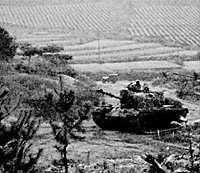 Introduction
Introduction
In June 1950, the North Korean People's Army (NKPA) struck south across the 38th parallel and pressed the few ill-equipped divisions of the Republic of Korea (ROK) Army and ill-prepared American rescuers back to a position in the southeast known as the "Pusan Perimeter." As the ROKs and the Americans held the line, US Far East commander and enigmatic military genius General Douglas MacArthur launched an amphibious invasion at the port of Inchon, which recaptured the ROK capital of Seoul and cut off the North Koreans from their supplies.
The ensuing ROKIUS offensive, under the banner of the United Nations, decimated the remainder of the NKPA and drove to the very banks of the Yalu River on the Red Chinese border. Ignoring intelligence indicators as well as diplomatic warnings, UNforces were surprised by the hammer blows of massive Chinese intervention forces, and chased back south of the 38th parallel. Indecisive warfare dragged on until an armistice was signed in 1953, leaving the combatants essentially in place and separated by a 4- kilometer-wide Demilitarized Zone - the new defacto border between North and South Korea.
The end of hostilities settled little between the two Koreas. The North's premier, Kim Il Sung, wanted to reunite the country by force and had tried. The South's president, Syngman Rhee, would have tried if he had had the resources. In the 40 years since the war, both sides have fortified the border area and built up vast military establishments against another day of reckoning. South Korea has gone on to become another Asian "economic miracle" while North Korea, like so many communist countries, has stagnated.
Kim Il Sung, in the middle of trying to establish the first communist hereditary monarchy, must now realize that time is about to run out on his chance to defeat the South militarily. The North is inferior in population and industry - a situation which can only continue to get worse. The North spends a quarter of its gross national product on the military, and maintains a standing force of 1,000,000 men with another 5,000,000 in reserve. If all of this effort is to be put to some use, it must be soon.
Across the DMZ The Next War in Korea
- Introduction
Environment and Forces
North Korean Tactical Doctrine
South Korean Tactical Doctrine
Scenarios and Sources
Back to Table of Contents: CounterAttack # 4
To CounterAttack List of Issues
To MagWeb Master Magazine List
© Copyright 1993 by Pacific Rim Publishing Company.
This article appears in MagWeb.com (Magazine Web) on the Internet World Wide Web.
Other articles from military history and related magazines are available at http://www.magweb.com